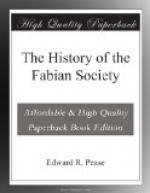In the autumn of 1912 Mrs. Webb came to the conclusion that the work of the National Committee for the Prevention of Destitution could not be carried on indefinitely on a large scale. Reform of the Poor Law was not coming as a big scheme. It was true that the Majority Report was almost forgotten, but there appeared to be no longer any hope that the Government would take up as a whole the scheme of the Minority Report. It would come about in due time, but not as the result of an agitation. The National Committee had a monthly paper, “The Crusade,” edited by Clifford Sharp, a member of the Society who came to the front at the time of the Wells agitation, had been one of the founders of the Nursery, and a member of the Executive from 1909 to 1914. In March, 1913, Bernard Shaw, H.D. Harben, and the Webbs, with a few other friends, established the “New Statesman,” with Clifford Sharp as editor. This weekly review is not the organ of the Society, and is not in any formal way connected with it, but none the less it does in fact express the policy which has moulded the Society, and it has been a useful vehicle for publishing the results of Fabian Research.
Fabian Research, the other outgrowth of the Committee for the Prevention of Destitution, was organised by Mrs. Webb in the autumn of 1912. Investigation of social problems was one of the original objects of the Society and had always been a recognised part of its work. As a general rule, members had taken it up individually, but at various periods Committees had been appointed to investigate particular subjects. The important work of one of these Committees, on the Decline of the Birth-rate, has been described in an earlier chapter. Mrs. Webb’s plan was to systematise research, to enlist the co-operation of social enquirers not necessarily committed to the principles of the Society, and to obtain funds for this special purpose from those who would not contribute to the political side of the Society’s operations.
The “Committees of Inquiry” then formed took up two subjects, the “Control of Industry” and “Land Problems and Rural Development.” The latter was organised by H.D. Harben and was carried on independently. After a large amount of information had been collected, partly in writing and partly from the oral evidence of specialists, a Report was drafted by Mr. Harben and published first as a Supplement to the “New Statesman” on August 4th, 1913, and some months later by Messrs. Constable for the Fabian Society as a half-a-crown volume entitled “The Rural Problem.”
In fact there is a consensus of opinion throughout all parties on this group of questions. Socialists, Liberals, and a large section of Conservatives advocate Wages Boards for providing a statutory minimum wage for farm labourers, State aid for building of cottages and a resolute speeding up in the provision of land for small holdings. The Fabian presentment of the case did not substantially differ from that of the Land Report published a few months later under Liberal auspices, and our Report, though useful, cannot be said to have been epoch-making.




